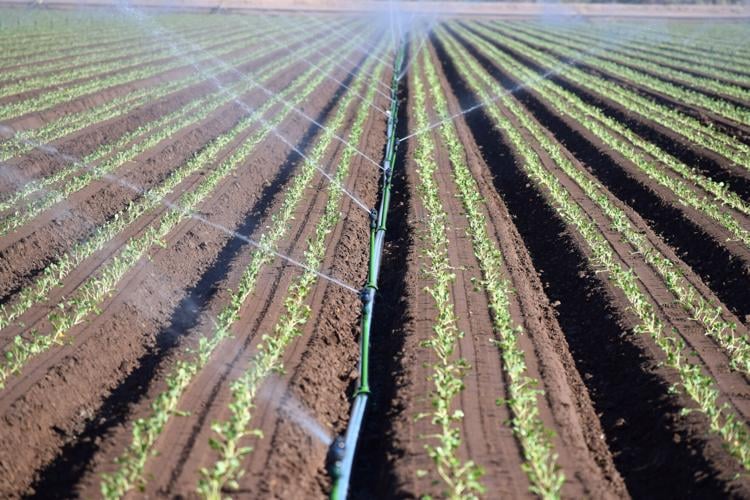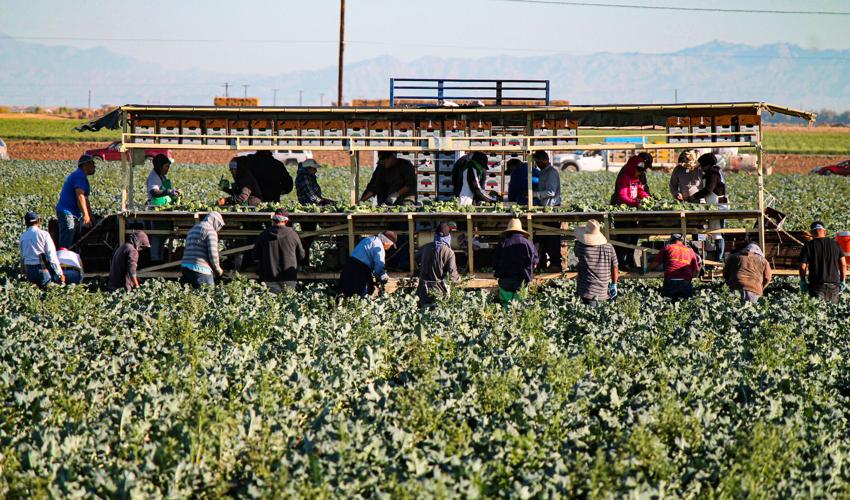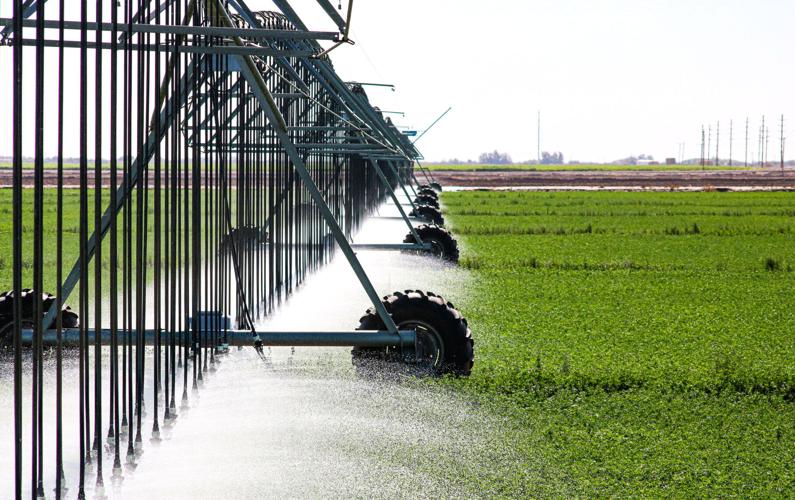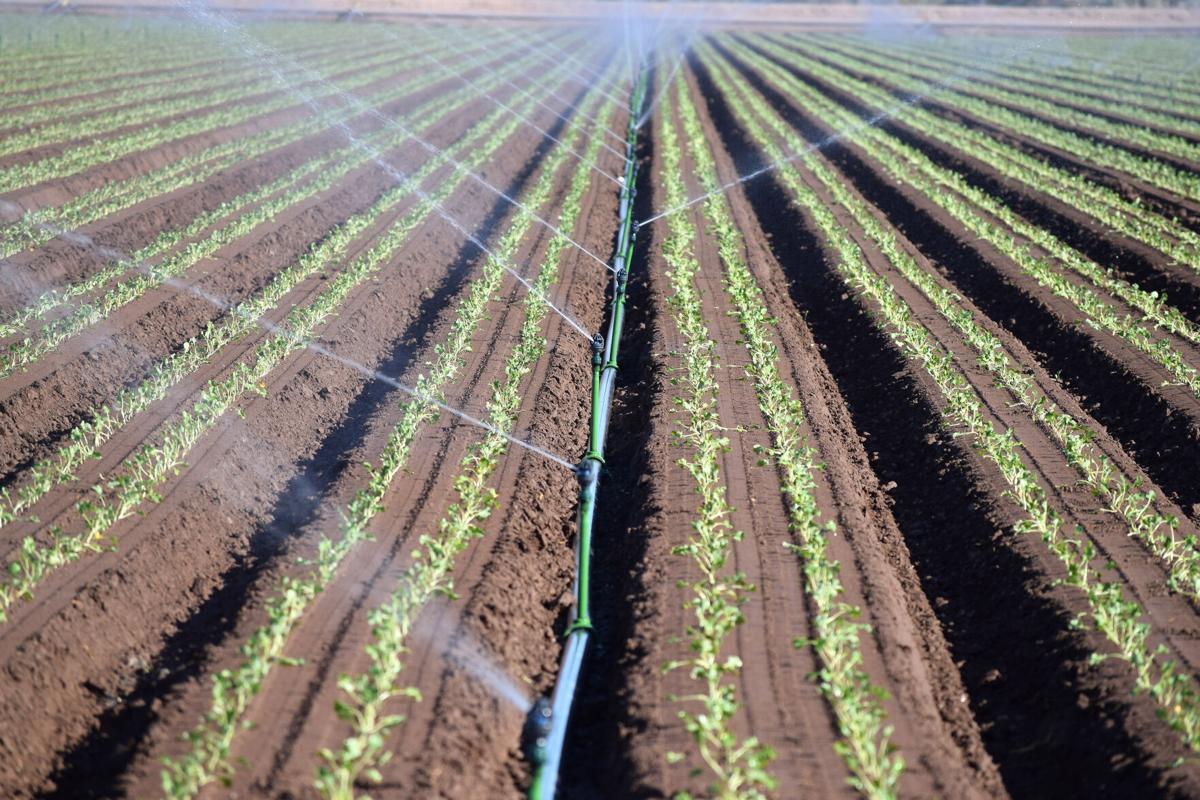Farmers along the Lower Colorado River in Southern Arizona and Southern California are bracing for severe reductions next year in their river water supplies — cuts they say could lead to widespread crop production cutbacks, major economic dislocation and, possibly, food shortages.
“Mass fallowing” is a prime concern among representatives of several big irrigation districts along the river. The concern is growing as farm, city, state and federal officials seek to negotiate a compromise solution to carry out cuts in water use across the entire Colorado River Basin that were ordered last month by the U.S. Bureau of Reclamation.
The bureau wants the seven river basin states to cut 2 million to 4 million acre-feet of water use next year. That amounts to up to nearly 30% of their total annual take from the river. The bureau says the cuts are needed to prevent Lakes Mead and Powell from falling so low they won’t be able to generate power or might even reach “dead pool,” where little or no water could be removed from them.
Farmers along the Lower Colorado will take a hefty slice of the cuts because they use the largest single share of river water in the Lower Basin, many experts say. In fact, the Imperial Irrigation District in Southern California west of Yuma owns the single largest share of river water rights in the entire basin.
Overall, the Lower Basin states of Arizona, California and Nevada are expected to take the largest share of cuts because they use more than twice as much water annually as the Upper Basin states of Utah, New Mexico, Colorado and Wyoming. A top Colorado water official, Rebecca Mitchell, said last week she believes the Lower Basin should take most of the cuts.
“You can’t get to cuts of that magnitude without significant cuts to agriculture. You just can’t,” said Kathryn Sorensen, a researcher for Arizona State University’s Kyl Center for Water Policy. “Who exactly that is, where exactly that is, I don’t know.”
“I understand that the growers have their contracts in for next year, for purchasers, for labor. These are businesses. They’re doing what they need to do to keep their businesses going. If there are significant cuts and a large portion goes to agriculture, I think you are looking at pretty significant fallowing. I don’t know how you get around that,” said Sorensen, adding, “I hope I’m wrong.”
Less food available?
With reductions scheduled to be finalized next month and to take effect in 2023, several farm leaders said in interviews that avoiding large-scale removal of farmland from production will be difficult to impossible to avoid.
“I’ve been told there are as many as 150 different crops grown in Yuma, depending on what the demand is for the crops. We can grow anything in the Yuma Valley, damn near anything. We grow year round — whatever needs to be grown for the rest of the country,” said Tom Davis, general manager of the Yuma County Water Users Association.
These farmers have long been national leaders in their production of food crops, with the Yuma area renowned for supplying at least 90% of the U.S.’s entire winter lettuce supply.
Farmers in the Imperial Valley, just west of the California-Arizona border, grow up to 200 crops, according to various reports and to agricultural leaders there.
If the reservoirs go dry, there will be a food shortage, and if officials must cut off water deliveries to avoid that, “there will be less food available, or if it is available, it will be more expensive,” said Davis, whose association represents farmers growing on about 45,000 acres in the Yuma area that are served by river water.
“Just think of a farm being the Abbott baby formula manufacturing plant,” Davis said. “You cut that back, you end up with a shortage somewhere unless you end up growing it somewhere else. You can’t grow all of what we grow here somewhere else, although you can grow some of it.”
But if the farmers do sustain heavy water use cuts, alfalfa growing — not winter vegetables — will take the biggest hit, said University of Arizona agricultural economist George Frisvold and University of New Mexico water researcher John Fleck.
Far more acres of alfalfa and other forage crops to feed cattle are grown along the Lower Colorado than vegetables. Cutting vegetable crops will be the last resort, Frisvold said.
And if alfalfa growing is slashed, a lot of the cuts will be felt in reduced exports, not in shortages in cheese and other dairy products in the U.S., Frisvold said.
“The bigger impacts are going to be in farming communities,” he said. People in Phoenix and Tucson aren’t “really going to notice this.”
At the same time, farmers hope to gain compensation for their expected financial losses. They’re trying to join forces, to negotiate from a position of strength with city water users along with state and federal officials as they try to come up with a plan acceptable to the bureau.
“We’re five little counties, 12 little irrigation districts, negotiating against Arizona, California and the federal government. We’re a bunch of little irrigation districts arm wrestling with 800-pound gorillas.
“But all together we’re a pretty strong gorilla,” too, said Alan Boyce, a farmer near the Yuma area and in the Imperial Irrigation District who is involved in efforts to organize farmers in Arizona and California.

Farmers in the Imperial Valley, just west of the California-Arizona border, grow up to 200 crops. The Imperial Irrigation District near El Centro, Calif., is shown here. But if the farmers do sustain heavy cuts in Colorado River water supplies, alfalfa growing — not winter vegetables — will take the biggest hit, say University of Arizona agricultural economist George Frisvold and University of New Mexico water researcher John Fleck.
Historic rights to water; heavy use
But they have become targets for criticism and for future water rights purchases by cities, which have long eyed the farms’ abundant, senior water rights as possible sources to replace what they’ll lose as the Colorado River continues its rapid decline.
Much of the criticism has stemmed from the farms’ heavy dependence on growing water-thirsty alfalfa and other feed crops, although that’s more common among Southern California farms than in the Yuma area.
Between them, farmers in the counties along the Lower Colorado used more than 4.5 million acre-feet of river water in 2021, Bureau of Reclamation records show.
That approaches 65% of the total river water use last year in the entire Lower Colorado Basin, although it’s less than the 70% to 80% that experts say agriculture uses of the entire river’s supply. (In the past, the Central Arizona Project also delivered a significant amount of water to farmers, particularly in Pinal County. But because of already declared shortages on the Colorado, the CAP was scheduled to provide only 42,000 acre feet to iagricultural users this year, and none in 2023).
For comparison, the Lower Basin’s two largest urban river water users, the three-county Central Arizona Project and the six-county Metropolitan Water District in Southern California, used about 2.4 million acre-feet total in 2021.
Many of the Lower Colorado farmers have senior river water rights, dating as far back as the 1860s. That gives them much higher legal priority for the water than urban users.
Agriculture also has produced economic largesse for the areas, although the region’s personal incomes are lower than those of their urban counterparts.
Yuma County agriculture produces nearly $3.4 billion worth of crops annually, county officials say. In Imperial County, agricultural output in 2019 totaled $2.9 billion annually in direct economic output, and more than $4.3 billion when indirect economic benefits are considered, said a study published by that county’s Agricultural Commissioner’s Office.
But these farmers are generally perceived as having less political clout than the big cities, since the five Lower Colorado riverfront counties have about 867,000 people, equivalent to less than 20% of Maricopa County’s 4.5 million people.
Bart Fisher, a governing board member for the Palo Verde Irrigation District, outside Blythe, California, noted the district already agreed in 2021 to fallow up to 19,461 of its 94,000 acres for three years starting this year, in return for $38 million in compensation from state and federal agencies.
“Then, if they come and say we need significantly more fallowing, what’s left to farm? What about our farmworkers? What about rural communities? When people don’t have employment, they are going to find employment somewhere else. We don’t want to be depopulated,” Fisher said.
Compensation sought for harm
The most specific forecast of economic harm to agriculture comes from Alan Boyce. Executive chairman of the Manterra Farming Company, Boyce oversees farming activities extending from the Imperial Valley to Central Arizona’s Pinal County to California’s Central Valley and beyond.
Academically trained as an economist, he spent two years as a Federal Reserve Board junior economist in the early 1980s and later worked for 30 years as a Wall Street bond trader.
In a slide show he has presented to several Lower Colorado farming communities, Boyce said the 12 irrigation districts in that area need to take a cut of about 2.2 million acre-feet, almost half their total river water supplies, to do their share to meet the Bureau of Reclamation’s goals for stabilizing the big reservoirs. He calls his effort “Save the River.”
A cut of that scale, he projected, would require fallowing of about 185,000 acres year-round with another 444,000 acres fallowed part of the year. That’s about 20% of a total of about 925,000 acres farmed in those districts.
The 2.2 million acre-feet is actually about twice as much as the river basin states are currently discussing cutting from Lower Basin farmers in their ongoing negotiations, various sources say. But Boyce said he believes a cut of less than 2 million won’t be adequate to protect the reservoirs in the long run.
To accomplish the needed water savings, “We need every irrigation district on the Lower Colorado to chip in or we cannot get there. Nobody rides for free,” he said in an email to the Arizona Daily Star.
As for what lands would be fallowed, he added, “Hopefully we pick the worst ground that grows the lowest value crops. There is a bunch of that out there, old lake bottoms, sand bars and sand dunes.”

The Imperial Irrigation District, shown here near El Centro, California, receives by far the biggest annual supply of Colorado River water in the lower river basin. As a result, many experts say the fate of agriculture in this region — and possibly the fate of the entire river — hinges on what happens in ongoing negotiations with the Imperial district.
He also projected the farms could save about 10% of their lost water without additional production cuts, by switching about 148,000 acres to more efficient practices such as drip irrigation. He would prefer to do that before resorting to large-scale land fallowing but said he doesn’t think the Lower Colorado farmers can all do it at once.
“Massive shortages and supply chain issues make this even harder, and prices of pumps and pipe are zooming. Drip tape? Skilled labor? Non existent,” he said in an email.
The production cuts required to carry out the needed fallowing would translate to about 32% in annual operating income losses across the five affected counties, three in Arizona and two in California.
That would trigger about 20,000 job losses, directly and indirectly, across the entire region, Boyce projected.
He said he based many of these conclusions on computer models used by University of California economists who studied impacts of similarly severe water cuts on San Joaquin Valley farmers.
He estimated that governments will have to pay the irrigation districts more than $11 billion during the period 2023 through 2026 to compensate them for the resulting economic harm.
“Like really. In a time of runaway food inflation and food shortages, stop farming? Who needs it?” asked Boyce, sarcastically.
“I would rather do anything with water use efficiency than with fallowing. But it’s too late,” he said. “The river is dying.”
Economic impact debated
UA economist Frisvold has little doubt that massive water cuts would hurt the Lower Colorado River farmers economically. But after reviewing Boyce’s slides, he said the farmer appears to have overstated the economic impacts.
The first crops to go will be “field crops” such as alfalfa, grasses such as durum wheat, corn and cotton, which are less profitable for farmers to grow, he said. “If the cuts are enough to start hitting higher value crops such as fruit and vegetables, and I don’t think they would be, then they are in a world of hurt,” Frisvold said.
“Early on there’s not going to be a lot of alternatives to fallowing. That’s one of the most costly ways to adjust. You’re basically cutting production all the way down to zero,” he said.
Looking at Boyce’s slides, he noticed that for the Yuma area, the farmer projected a reduction in 69,350 acres of cropland would mean a loss of $768 million in net operating income, or $11,333 per acre.
But a 2017 study from the federal Bureau of Economic Analysis concluded that Yuma-area farmers earn a little more than $7,300 an acre in gross income, before expenses are considered, Frisvold said. Using a conservative estimate of crop production expenses would reduce the farmers’ operating income to below $4,000 an acre, “likely even lower,” he said.
Replying, Boyce said the federal economic bureau inaccurately estimates the total irrigation acreage in the Yuma area, because there’s no mandatory reporting of crop acreage to local government in Arizona, unlike in California. That leads to an undercount of farm income per acre, he said.
Also, farm income today is higher than in 2017 because crop prices “are way higher than in 2017 — if they weren’t higher, we would all be bankrupt because our costs are up a bunch,” he added.

The intake towers that feed Hoover Dam’s power generators are almost fully exposed as the Lake Mead water level continues to decline. This photo was taken in June 2022.
Targeting thirsty, exported alfalfa
One water-saving program that governments at all levels could carry out is for that whole region to halt summertime irrigation of alfalfa, said UA law professor Robert Glennon, who has written two books about water and has advocated for that solution for years.
Much alfalfa is exported to other countries, leading critics to say the Southwest is exporting much of its water overseas.
In 2012, Glennon and Phoenix water attorney Peter Culp wrote an article saying the Imperial Irrigation District’s alfalfa farmers use up to 50% more water than other California growers “due to scorching heat, salty soil, and perhaps most important, their legal rights to an enormous quantity of cheap water.”
“It’s a no brainer thing to curb alfalfa planting in the summer,” Glennon said in an interview last month.
“Alfalfa uses four times as much water in the summer as any other cutting of the crop during the year. The quality of the alfalfa is not as good as other times and the quantity isn’t as good. Farmers say they can’t do that, that the alfalfa stand would die. You focus first on alfalfa that’s been in the ground for four or five years and in the worst case you pay farmers for one to two years worth of summer crops if it doesn’t come back in September,” Glennon said.
Glennon said he believes that could save a substantial amount of water, since the Imperial Irrigation District farmers grew 147,000 acres of alfalfa in 2021 — more acres than the next three most heavily planted crops combined.
He has long advocated paying farmers to convert to more water-efficient irrigation methods.
The U.S. Department of Agriculture reported in 2018 that alfalfa uses 5.8 acre-feet of water per acre in Arizona and 3.7 per acre in California.
Lettuce, by contrast, uses only 2.4 acre-feet per acre in Arizona, although it uses more, 4.2 acre-feet per acre, in California. Tomatoes, rarely grown in Arizona, require only 2.5 acre-feet per acre in California and potatoes and berries have similarly low water use, the USDA says.
‘What happens to the region’
UNM’s Fleck, an author and water researcher, said he definitely expects to see “a lot less irrigated land down there very, very quickly.”
He, too, expects a substantial reduction in lower value crops such as alfalfa, but is less certain about the broader economic impacts.
“We will have an agricultural community that looks very different down there, for some period of time, maybe forever,” Fleck said. “But what happens to the region will depend on two things: How much money is paid to compensate for their water and crop losses, and where does that money go?
“How much of that goes to the landowner and how much to the farmer who leases from them? What about the tractor dealers? What about the pesticide specialists? How do we cushion that impact on them? That’s hard to know. We don’t know what this system will look like and those are really important questions.”
Biggest water user is key to future
Many observers have long said the fate of agriculture in this region, and possibly the fate of the entire river, will hinge on what happens in the ongoing negotiations with the Imperial Irrigation District.
That’s because its 2.5 million acre-foot annual supply of river water more than doubles what any other user in the entire basin receives. That, in turn, means most water experts agree that without Imperial’s participation in water use cuts, there’s no way to fix the river’s increasing deficit between water supplies and demands.
“Two to four million acre-feet is an eye-popping number, certainly. We’ve never dealt with anything like that in the Colorado River Basin,” said J.B. Hamby, a district governing board member. “There’s a recognition that living with less for at least a temporary time is better than nothing at all.
“In the Imperial Valley 100% of our water comes from the Colorado River. We have no other systems to depend on. If we lose Lake Mead, the Imperial Valley has no water,” Hamby said. “It’s important for us to be part of the solution. The question is, what can we come up with in this very short time frame?”
The only way to save that much water quickly in the district would be through a temporary, emergency fallowing program, “not permanent,” he said.
“That’s always been an f-word here. We don’t like it,” Hamby said. “Can we contribute in the short term to make sure Mead doesn’t get to dead pool? Yes.
“In the long run, we don’t want to do (fallowing). We want to be a farming community. There are other system-wide, water conservation agreements that could replace a temporary fallowing program. That will also require investment at the federal level,” Hamby said.
“First and foremost,” however, he said Colorado River negotiators must deal with the fact that any reductions in river supplies to the Imperial Valley will also reduce water flows to the highly imperiled Salton Sea, nearby, because Imperials farmers’ irrigation runoff water is the sea’s main water source.
As valley water use has declined since earlier cuts were made two decades ago, the shrinking sea has contributed to major declines in fish and bird populations and increases in toxic air emissions from its blowing dust.
“It is unlikely we would agree to anything in water cutbacks unless there were strong Salton Sea commitments, binding federal and state commitments,” Hamby said, and Fleck agrees.
“The more water we lose,” Hamby noted, “the more impacts, the more consequences it’s going to have, on human life and wildlife.”








